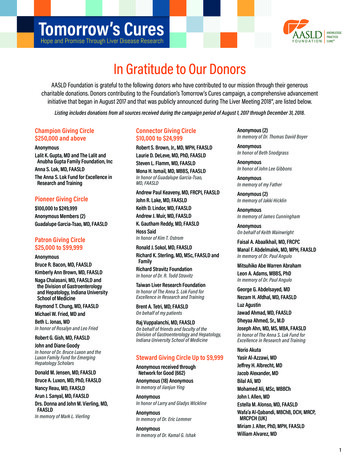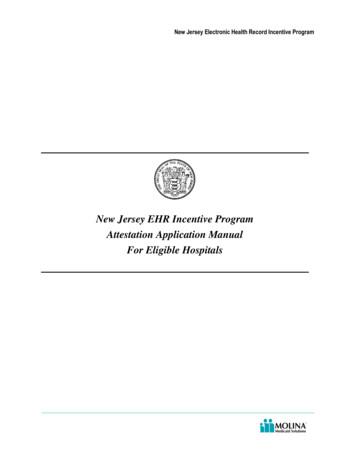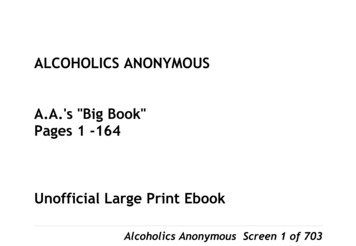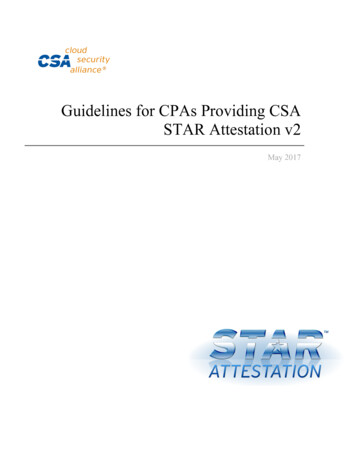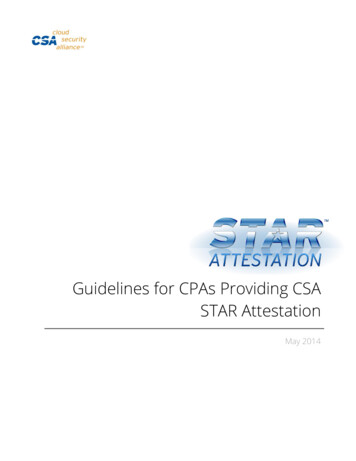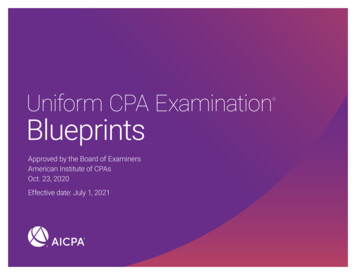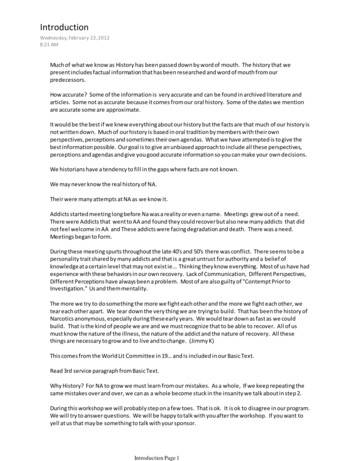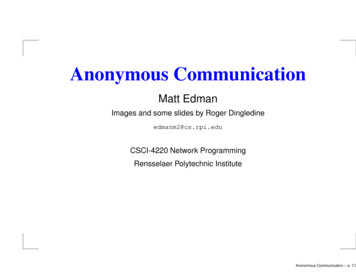
Transcription
Direct Anonymous Attestation with Optimal TPM Signing EfficiencyKang Yang1 , Liqun Chen2 , Zhenfeng Zhang3 , Christopher J.P. Newton2 , Bo Yang4 , and Li Xi31State Key Laboratory of Cryptology, Beijing 100878, Chinayangk@sklc.org2University of Surrey, UK{liqun.chen, c.newton}@surrey.ac.uk3Trusted Computing and Information Assurance Laboratory, SKLCS,Institute of Software, Chinese Academy of Sciences, Beijing 100190, China{zfzhang, xili}@tca.iscas.ac.cn4Bank Card Test Center, Beijing, ChinaNational Financial IC Card Security Test Center, Beijing, Chinayangbo@bctest.comAbstract. Direct Anonymous Attestation (DAA) is an anonymous signature scheme, which allows the TrustedPlatform Module (TPM), a small chip embedded in a host computer, to attest to the state of the host system,while preserving the privacy of the user. DAA provides two signature modes: fully anonymous signatures andpseudonymous signatures. One main goal of designing DAA schemes is to reduce the TPM signing workload asmuch as possible, as the TPM has only limited resources. In an optimal DAA scheme, the signing workload on theTPM will be no more than that required for a normal signature like ECSchnorr. To date, no scheme has achievedthe optimal signing efficiency for both signature modes.In this paper, we propose the first DAA scheme which achieves the optimal TPM signing efficiency for bothsignature modes. In this scheme, the TPM takes only a single exponentiation to generate a signature, and this singleexponentiation can be pre-computed. Our scheme can be implemented using the existing TPM 2.0 commands, andthus is compatible with the TPM 2.0 specification. We benchmarked the TPM 2.0 commands needed for three DAAuse cases on an Infineon TPM 2.0 chip, and also implemented the host signing and verification algorithm for ourscheme on a laptop with 1.80GHz Intel Core i7-8550U CPU. Our experimental results show that our DAA schemeobtains a total signing time of about 144 ms for either of two signature modes (compared to an online signing timeof about 65 ms). Based on our benchmark results for the pseudonymous signature mode, our scheme is roughly 2 (resp., 5 ) faster than the existing DAA schemes supported by TPM 2.0 in terms of total (resp., online) signingefficiency.In addition, our DAA scheme supports selective attribute disclosure, which can satisfy more application requirements. We also extend our DAA scheme to support signature-based revocation and to guarantee privacy againstsubverted TPMs. The two extended DAA schemes keep the TPM signing efficiency optimal for both of two signature modes, and outperform existing related schemes in terms of signing performance.Keywords: Direct anonymous attestation · TPM 2.0 implementation · Anonymous signatures · Provable security1IntroductionWith the rapid growth of devices connected to the internet, it is becoming increasingly difficult to securethese devices [CCD 17]. To achieve better security, one approach is to place a root of trust such as a TrustedPlatform Module (TPM) into such devices and use this to attest to the current state of the device. It is crucialthat such attestations are privacy-preserving. On the one hand, anonymous attestation protects the privacyof owners of the devices, which adhere to one of the essential elements of privacy-enhancing systems (i.e.,disassociability) developed by NIST [NIS15]. On the other hand, it minimizes the information available tothe adversary and satisfies the so-called data minimization principle [PH10]. In addition, the protection ofusers’ privacy now receives more attention because of the introduction of Europe’s new privacy regulations(General Data Protection Regulation (GDPR) [GDP16]).The Trusted Computing Group (TCG), an industry standardization group, has used Direct AnonymousAttestation (DAA) to realize such attestations in a privacy-preserving manner. Both the TPM 2.0 specification [Tru16] and the corresponding ISO/IEC 11889 standard [ISO15] specify the use of DAA for anonymous
attestation, while DAA itself has also been standardized in ISO/IEC 20008-2 [Int13]. The TPM 2.0 specification [Tru16] supports multiple ECDAA schemes which are built on pairing-friendly elliptic curves. Inparticular, Chen and Li [CL13] described the TPM 2.0 commands needed to implement two alternativeDAA schemes [CPS10, BL10b]. The flexibility of these commands means that they can also be used toimplement further ECDAA schemes. For example, the DAA scheme by Camenisch et al. [CDL16a] can beimplemented using these TPM 2.0 commands. More than a billion devices include TCG technologies, wherevirtually all enterprise PCs, many servers and embedded systems include TPMs and are in compliance withthe TPM 2.0 specification [Tru20]. It is crucial to design DAA schemes that are compatible with TPM 2.0.A TPM, which is a small chip embedded in a host platform, can use DAA to attest to either the currentstate of the host system or the particular computations made, while preserving the user’s privacy. DAA provides two signature modes so that a user can decide whether a signature should be linkable to other signaturesor not. Specifically, signatures w.r.t. the empty basename bsn are fully anonymous (i.e., unlinkable).Alternatively, signatures w.r.t. a non-empty basename bsn 6 are pseudonymous, meaning that signaturesunder the same basename are linkable, while signatures under different basenames are unlinkable. In someapplications such as anonymous subscription [KLL 18] and vehicular communication (V2X) [WCG 17],pseudonymous signatures may be preferable or required for system operations. Pseudonymous signaturesprovide an advantage of allowing users to create pseudonyms at a service provider and obtain value-addedservices.The TPM is a small discrete chip with only limited resources, while the host is more powerful (e.g., thehost is about a factor of 300 faster than the TPM according to the experimental results [CL13, BCN14]).However, the host is much less secure than the TPM. As pointed out by Camenisch et al. [CDL16b], themain challenge in designing DAA schemes is to distribute the computational work between the TPM andthe host such that the workload of the TPM is as small as possible, while this does not affect the security.In an optimal DAA scheme, the signing workload on the TPM will be no more than that required for anormal signature such as ECSchnorr [Sch91, Tru16]. Specifically, only one exponentiation is required forthe TPM when generating a signature, where one exponentiation is necessary to prevent the corrupted hostfrom forging signatures without interacting with the TPM. Informally, we say that the signing efficiencyof the TPM in a DAA scheme is fully optimal if the TPM takes only a single exponentiation per signaturegeneration for both of two signature modes, and partially optimal if one exponentiation holds for only onesignature mode.The ECDAA schemes fall into two categories: 1) LRSW-DAA schemes [BCL08, CMS08, CPS10,BFG 13a, BCL12, CDL16b] based on the LRSW assumption [LRSW99] or its variants; and 2) SDHDAA schemes [CF08, Che10, BL10b, CDL16a] based on the q-SDH assumption [BB08]. DAA has developed over fifteen years, and the signing efficiency of the TPM is improved gradually. However, only theLRSW-DAA schemes [BFG 13a, BCL12] achieves the partially optimal TPM signing efficiency for thefully anonymous signature mode. Furthermore, the best known SDH-DAA scheme [CDL16a] requires threeexponentiations for the TPM to generate a signature for both of two signature modes.1.1Our ContributionsIn this paper, we propose the first DAA scheme with fully optimal TPM signing efficiency and denote itby DAAOPT . That is, DAAOPT only requires the TPM to carry out a single exponentiation in a prime-ordergroup when creating a signature for both of two signature modes. Moreover, the single exponentiation canbe pre-computed, which allows DAAOPT to obtain fast on-line signing. Additionally, we present a simplemethod of parallel computation to reduce the signing time on the host side. Our scheme DAAOPT is provablysecure under the DDH, DBDH and q-SDH assumptions in the random oracle model.Our scheme DAAOPT is compatible with the TPM 2.0 specification, i.e., DAAOPT can be implementedusing the existing TPM 2.0 commands. We consider TPM 2.0 implementations of three DAA use cases
(i.e., quoting PCR values, certifying a TPM key, and signing an arbitrary message given by the host). Webenchmarked the TPM 2.0 commands on an Infineon TPM 2.0 chip, which allows one to evaluate the TPMefficiency. We also implemented the host signing and the verification algorithm for our scheme DAAOPTon a laptop with 1.80GHz Intel Core i7-8550U CPU over the BN P256 curve using the AMCL library.Together with our benchmark results for the TPM 2.0 commands, we find that DAAOPT needs about 138.3ms for signing in the fully anonymous case and 144 ms for the pseudonymous case. When pre-computationis considered, the time of online signing reduces to 50 ms and 64.6 ms respectively. In terms of verificationefficiency, DAAOPT takes 5.9 ms for the fully anonymous signature mode and 8.1 ms for the pseudonymoussignature mode. Specifically, our scheme DAAOPT is roughly 2 faster for total signing and 5 faster foronline signing than the existing DAA schemes supported by TPM 2.0 in the pseudonymous signature mode.When generating a fully anonymous signature, DAAOPT is about 2 more efficient than the known SDHDAA schemes supported by TPM 2.0. Our scheme DAAOPT has the same efficiency as the state-of-the-artLRSW-DAA scheme compatible with TPM 2.0 in terms of generating fully anonymous signatures, and ismore efficient than this scheme for verification.In addition, our DAA scheme DAAOPT supports selective attribute disclosure, which can satisfy moreapplication requirements. We also extend DAAOPT to support signature-based revocation and to guarantee privacy in the presence of subverted TPMs. The two extended DAA schemes keep the TPM signingefficiency fully optimal, and provide significantly better signing performance than known related schemes.1.2Applications of Our DAA SchemeWe outline three types of applications for our DAA scheme DAAOPT depending on what DAA signaturesare used for. In Section 5, we present how to use the TPM 2.0 commands to implement our DAA schemewith three use cases in order to support these types of applications.A PPLICATION I (a signature is used to quote PCR values): We can apply DAAOPT to remote attestation,where we report on (a.k.a. quote) the Platform Configuration Register (PCR) values recording the currentstate of the host system, while preserving the privacy of users. Additionally, our scheme DAAOPT withthe pseudonymous signature mode can be applied to V2X [WCG 17] via attesting to the current status ofthe vehicle which is recorded in the PCR values. In these applications, our scheme DAAOPT provides theadvantage of fast attestation/authentication.A PPLICATION II (a signature is used to certify a TPM key): We can apply DAAOPT to the Fast IDentityOnline (FIDO) authentication framework [FID17] to eliminate the unacceptably high risk in the FIDO basicattestation scheme that an attestation key is shared across a set of authenticators with identical characteristics.In this application, the TPM creates a new authentication key, and generates a fully anonymous signature(by cooperating with the host) to certify that the key is stored properly in the TPM. The FIDO allianceis in the process of standardizing a specification called FIDO ECDAA [CDE 17], which requires threeexponentiations for the TPM to generate a signature. When applying DAAOPT with a fully anonymoussignature mode to the FIDO authentication framework, we can reduce the TPM signing cost from threeexponentiations in FIDO ECDAA to only one exponentiation.A PPLICATION III (a signature is used to sign an arbitrary message given by the host): We can also applyDAAOPT to construct an anonymous authentication scheme by combining it with TLS [CLR ], to supportanonymous public transportation systems [ALT 15], or to realize anonymous subscriptions [KLL 18]. Forthese applications, our scheme DAAOPT not only prevents the sharing of credentials under the assumptionthat malicious users cannot extract secret keys from the TPMs, but also provides fast authentication.In addition, for mobile devices, Raj et al. [RSW 16] presented the implementation of a firmware-basedTPM (fTPM) using ARM TrustZone, which supports the TPM 2.0 specification. As a result, we can alsoapply DAAOPT to mobile devices with ARM TrustZone by using fTPM to perform the TPM operations, and
provide the advantage of better on-line signing performance and smaller Trusted Computing Base (TCB),compared to known DAA schemes supported by TPM 2.0.1.3Related WorkThe original DAA scheme was introduced by Brickell, Camenisch and Chen [BCC04], but requires the TPMto compute exponentiations over a large RSA modulus, which leads to the costly computational burden forthe TPM. Later, more efficient ECDAA schemes were proposed.Brickell et al. [BCL08] proposed the first LRSW-DAA scheme over symmetric bilinear groups. Thisscheme is further improved in [CMS08, CPS10] over asymmetric bilinear groups. Bernhard et al. [BFG 13a]utilized the special algebraic structure of randomized credentials, which implicitly contain unlinkable tags,to minimize the TPM’s signing cost for fully anonymous signatures. However, their LRSW-DAA schemestill requires three exponentiations for the TPM to create a pseudonymous signature. Brickell et al. [BCL12]uses a batch proof and verification technique to construct the most efficient LRSW-DAA scheme for now,which reduces the TPM signing cost to two exponentiations per pseudonymous signature. However, thisscheme is not compatible with the TPM 2.0 specification [Tru16]. Canard et al. [CPS14] proposed an efficient approach to delegate some computation of the TPM to the host in interactive zero-knowledge proofsof knowledge. Using their method to the proof of knowledge for pseudonymous signatures in the DAAscheme [BFG 13a], they show that the online signing cost of TPM can be reduced to one exponentiation.However, their approach is not compatible with the TPM 2.0 specification.Chen and Feng [CF08] presented the first SDH-DAA scheme. Chen [Che10] improved the signing efficiency of the TPM via removing an element of the credential. Brickell and Li [BL10b] further improved thesigning efficiency of the TPM by changing the way of delegation computation between the TPM and host.Later, Camenisch et al. [CDL16a] proposed an efficient proof of knowledge for BBS signature [ASM06],and then constructed an SDH-DAA scheme, which improves the signing efficiency on the host side. Theirscheme is the most efficient SDH-DAA scheme for now, but still requires three exponentiations for the TPMto generate a signature for both modes of signatures.Chen and Urian [CU15] introduced DAA with attributes, which extends DAA to support attributes (e.g.,the manufacturer and model version of the platform and an expiration date of the credential etc.), and toallow selective attribute disclosure (i.e., a user can choose to disclose a part of attributes but undisclosedattributes keep hidden). They proposed two DAA schemes with attributes by extending the LRSW-DAAscheme [CPS10] and the SDH-DAA scheme [BL10b] respectively, where their schemes allow the TPMto protect multiple attributes. Later, Camenisch et al. [CDL16a] proposed an SDH-DAA scheme with attributes, which stores all attributes on the host to obtain better efficiency. All these DAA schemes withattributes [CU15, CDL16a] can still be implemented using the TPM 2.0 commands.Brickell and Li [BL07, BL10a] introduced Enhanced Privacy ID (EPID), which extends DAA withsignature-based revocation. This revocation extension allows one to revoke a platform, based on a previous signature from the platform, even if the signature is fully anonymous. While private key revocation inDAA allows to revoke a platform by adding the platform’s secret key to the revocation list, signature-basedrevocation allows for revocation without knowing the secret key of the platform and is an improvementover private key revocation. The pairing-based EPID scheme [BL10a] is recommended by Intel to serveas the industry standard for privacy-preserving authentication in Internet of Things (IoTs). These EPIDschemes [BL07, BL10a] require 6nr exponentiations for the TPM to prove that the platform has not beenrevoked, where nr is the size of the signature revocation list. This is too expensive for a TPM with limitedresources. Recently, Camenisch et al. [CDL16a] showed how to delegate the TPM’s partial computations tothe host in the signature-based revocation, which reduces the overhead of the TPM to 3nr exponentiations.However, it is still too expensive for the TPM with limited resources.
Camenisch et al. [CDL17, CCD 17] considered the case that the TPMs are possible to be subverted,i.e., the TPMs are created by a compromised manufacturer. They proposed several DAA schemes in thiscase. Following the technique in [CCD 17], we extend our scheme DAAOPT to guarantee privacy againstsubverted TPMs in Appendix B.2, which obtains better signing performance than their schemes.A DAA variant called pre-DAA requires all the computation on the platform side takes place entirely onthe TPM, and will be useful for some applications such that the host has a similar resource as the TPM, e.g.,some use cases in Machine-to-Machine (M2M) and IoTs. Several pre-DAA schemes [BFG13b, DLST14,Gha16, BDGT17] have been proposed, where the scheme by Barki et al. [BDGT17] achieves the best performance. For some applications where the TPM has similar resources to the host, our DAA scheme isless efficient than the pre-DAA scheme [BDGT17]. Nevertheless, our DAA scheme provides a significantperformance advantage compared to the state-of-the-art DAA schemes [CPS10, BL10b, CDL16a], in manyapplications where the TPM has far fewer resources than the host.1.4OrganizationWe present the preliminaries in Section 2. We recall the definitions of DAA schemes in Section 3. In Section 4, we present the construction of our DAA scheme DAAOPT and two ways to further improve theefficiency of DAAOPT . In Section 5, we present the TPM 2.0 implementation of our DAA scheme involving three use cases. We evaluate the performance of our DAA scheme and compare it with known DAAschemes supported by TPM 2.0 in Section 6. Signature-based revocation extension of our DAA scheme isshown in Appendix B.1, and we extend our DAA scheme to guarantee privacy against subverted TPMs inAppendix B.2. We provide an alternative description of our DAA scheme for UC security in Appendix C,and give a full formal security proof in Appendix D.22.1PreliminariesNotation Throughout this paper, we denote the security parameter by λ. We use x S to denote that sampling xuniformly at random from a finite set S. For a group G, G denotes the set G\{1G }, where 1G is the identityelement of G. We use [n] to denote the set {1, . . . , n}. We say that a function f : N [0, 1] is negligible iffor every positive polynomial poly(·) and all sufficiently large λ such that f (λ) 1/poly(λ). We say that afunction f is overwhelming if 1 f is negligible.2.2Bilinear GroupsLet G be a probabilistic polynomial time (PPT) bilinear-group generator that on input a security parameter1λ , outputs a bilinear group Λ (p, G1 , G2 , GT , e, g1 , g2 ), where G1 , G2 and GT are groups of prime orderp, g1 and g2 are the generators of G1 and G2 respectively, and e : G1 G2 GT is a bilinear map.We say that e : G1 G2 GT is a bilinear map (pairing) if it is efficiently computable and satisfiesthe following properties: 1) bilinearity, i.e., e(g1a , g2b ) e(g1 , g2 )ab a, b Zp ; 2) non-degeneracy, i.e.,e(g1 , g2 ) 6 1GT for all generators g1 G1 and g2 G2 . Following [GPS08], pairings are categorizedinto three types: 1) Type-1 pairings (a.k.a. symmetric pairings) have G1 G2 ; 2) Type-2 pairings requireG1 6 G2 , but there exists an efficiently computable isomorphism ψ : G2 G1 such that g1 ψ(g2 );3) Type-3 pairings provide G1 6 G2 , but now there is no efficiently computable isomorphisms betweenG1 and G2 . Type-2 and Type-3 pairings are called asymmetric pairings. Throughout this paper, we onlyconsider Type-3 pairings.
2.3Signature Proofs of KnowledgeWe will use the notation introduced by Camenisch and Stadler [CS97] to abstract Signature Proofs of Knowledge (SPKs) on proving knowledge of discrete logarithms and statements about them. The SPKs can beobtained using Fiat-Shamir heuristic [FS86] to transform the corresponding Sigma protocols. For instance,π SPK{(x) : y g x }(m) denotes a signature proof of knowledge π on a message m, which provesknowledge of a witness x such that y g x , where G hgi is a group of prime order p. The SPKsare zero-knowledge via programming the random oracle and knowledge extractable in the random oraclemodel [PS00].2.4AssumptionsAssumption 1 (DBDH). We say that the Decisional Bilinear Diffie-Hellman (DBDH) assumption [BB04]holds for G if any PPT adversary A and Λ (p, G1 , G2 , GT , e, g1 , g2 ) G(1λ ), there exists a negligiblefunction ν(·) such thatPr[a, b, c Zp : A(Λ, g1a , g2b , g1c , g2c , e(g1 , g2 )abc ) 1] Pr[a, b, c, d Zp : A(Λ, g1a , g2b , g1c , g2c , e(g1 , g2 )d ) 1] ν(λ). In fact, the above assumption is an asymmetric version of the original DBDH assumption [BB04] forsymmetric bilinear pairings. Desmoulins et al. [DLST14] used an analogous asymmetric version of theoriginal DBDH assumption, where the adversary is given an additional element g1b as input. Freire et al.[FHKP13] used an asymmetric version of the original DBDH assumption over Type-2 pairings (DBDH-2)as introduced in [Gal05], where the adversary is given (g2 , g1a , g2b , g2c ) as input. For Type-2 pairings, the elements g1b and g1c can be computed via ψ(g2b ) and ψ(g2c ) respectively. Thus, the adversary is actually given(g1 , g2 , g1a , g1b , g2b , g1c , g2c ) as input in the DBDH-2 assumption.Assumption 2 (DDHG1 ). We say that the Decisional Diffie-Hellman (DDH) assumption [Bon98] holds ingroup G1 if for any PPT adversary A and Λ (p, G1 , G2 , GT , e, g1 , g2 ) G(1λ ), there exists a negligiblefunction ν(·) such thatPr[a, b Zp : A(Λ, g1a , g1b , g1ab ) 1] Pr[a, b, c Zp : A(Λ, g1a , g1b , g1c ) 1] ν(λ). Assumption 3 (q-SDH). We say that the q-Strong Diffie-Hellman (q-SDH) assumption [BB08] holds for Gif for any PPT adversary A and Λ (p, G1 , G2 , GT , e, g1 , g2 ) G(1λ ), there exists a negligible functionν(·) such that1/(γ c)Pr[γ Z p : (g1 q, c) A(Λ, g1γ , . . . , g1γ , g2γ )] ν(λ),where c Zp \{ γ}.3Definitions of DAA SchemesIn this section, we review the syntax of DAA schemes and the desired security properties for DAA, i.e.,anonymity, unforgeability and non-frameability. We adopt the security model for DAA by Camenisch etlal. [CDL16b], which is defined as an ideal functionality Fdaain the Universal Composability (UC) framework [Can01]. We extend this model to support the functionality of attributes by following the extension [CDL16a]. We refer the reader to Appendix A (or [CDL16b, CDL16a]) for the formal security definition of DAA in the form of an ideal functionality.
3.1Syntax of DAA SchemesIn a DAA scheme, there are four types of parties: TPM Mi and host Hj constituting a platform, issuer Iand verifier V. The DAA scheme consists of three algorithms Setup, Verify and Link, and two protocolsJoin and Sign.Setup. Given a set of system parameters params on a security parameter λ, an issuer I generates its publickey ipk and secret key isk, where params and ipk are publicly available. We assume that params and ipk areimplicit inputs for the following protocols and algorithms.Join. This is an interactive protocol between a platform (Mi , Hj ) and the issuer I who decides whetherthe platform is allowed to become a member. By executing the join protocol, the platform creates a secretkey gsk , and receives a number of attributes attrs (a1 , . . . , an ) and a credential cre given by I. Thecredential cre certifies the secret key gsk and attributes attrs, where the attributes include more informationabout the platform such as the manufacturer and model version and an expiration date of the credential etc.Sign. After being a member, a TPM Mi and a host Hj can jointly sign a message m w.r.t. a basename bsnresulting in a signature σ, where bsn is either the name string of a verifier or a special symbol . We referto σ as a fully anonymous signature if bsn and a pseudonymous signature otherwise. The platformcan also selectively disclose a part of attributes from its credential cre, e.g., disclosing that the signaturewas created by a TPM of a certain manufacturer or the expiration date of the credential. We denote thedisclosure of attributes by (D, I), where D {1, . . . , n} is a set indicating which attributes are disclosed,I (a1 , . . . , an ) is a tuple specifying the disclosed attribute values, and ai is set as if the i-th attribute isnot disclosed. We also denote by D̄ the set of the indices of undisclosed attributes, i.e., D̄ {1, . . . , n}\D.Verify. Given a message m, a basename bsn, a signature σ, an attribute disclosure (D, I) and a revocationlist RL consisting of the secret keys of corrupted platforms, a verifier V can run a deterministic verificationalgorithm to check that σ is valid on m w.r.t. bsn and stems from a platform that holds a credential satisfyingthe predicate defined by (D, I). The verification algorithm outputs 1 if the check passes and 0 otherwise.The revocation list RL is used to support private key revocation. When a secret key (private key) of acorrupted platform is exposed, the secret key would be added to RL, which allows a verifier to recognize andthus reject all the signatures created by the secret key.Link. On input two message/signature pairs (m0 , σ0 ) and (m1 , σ1 ), attribute disclosure (D0 , I0 ) and (D1 , I1 )and a basename bsn 6 , a verifier V can run a deterministic link algorithm to decide whether the two signatures link or not. If both σ0 and σ1 are valid on respective (m0 , (D0 , I0 )) and (m1 , (D1 , I1 )) w.r.t. thesame bsn 6 and were produced by the same secret key, the link algorithm outputs 1 (linked). Otherwise,the link algorithm outputs if one of σ0 and σ1 is invalid and 0 (unlinked) otherwise.3.2Desired Security Properties for DAAFollowing the work [CDL16b], a DAA scheme should satisfy the following desired security properties:Anonymity. Given two signatures with respect to different basenames or bsn , no adversary can distinguish whether both signatures were generated by the same honest platform, or whether they were createdby two different honest platforms. The property requires that the entire platform (TPM host) is honest, andshould hold even if the issuer is corrupted.Unforgeability. This property requires that the issuer is honest, and should hold even if some or all hostsare corrupted.1. If all unrevoked TPMs are honest, no adversary can produce a signature on a message m w.r.t. a basename bsn and attribute disclosure (D, I), when no platform that joined with those attributes signed mw.r.t. bsn and (D, I).
2. An adversary can only sign in the name of corrupted TPMs. More precisely, if k corrupted and unrevokedTPMs joined with attributes fulfilling attribute disclosure (D, I) for some integer k, the adversary cancreate at most k unlinkable signatures w.r.t. the same basename bsn 6 and attribute disclosure (D, I).Non-frameability. No adversary can create a signature on a message m w.r.t. a basename bsn which linksto a signature created by an honest platform, when the platform never signed m w.r.t. bsn. The propertyrequires that the entire platform is honest, and should hold even if the issuer is corrupted.4Our DAA SchemeWe present the construction of our DAA scheme (denoted by DAAOPT ). Our scheme DAAOPT supports selective attribute disclosure, and would be degraded as a standard DAA scheme when removing the attributes(i.e., n 0). Following [CDL16a], we consider that only the secret key is protected by the TPM and allattributes are stored on the host in order to obtain better efficiency. We will further improve the computational efficiency of DAAOPT by presenting online/offline DAA signatures and a simple method of parallell with static corruption andcomputation. We prove that protocol DAAOPT securely realizes functionality Fdaaattributes defined in [CDL16b, CDL16a] under the DBDH, DDHG1 and q-SDH assumptions in the randomoracle model, based on the proofs by Camenisch et al. [CDL16b, CDL16a]. We informally argue the security of DAAOPT in this section, and give the detailed security proof in Appendix D. First of all, we describethe high-level ideas underlying the construction of DAAOPT .4.1High Level IdeasOur scheme follows the basic framework of DAA [BCC04], where a platform (consisting of TPM and host)obtains a credential from the issuer in the join protocol, and then in the sign protocol, proves knowledge ofthe credential, as well as generating a pseudonym/unlinkable-tag, and proving in zero-knowledge correctnessof the pseudonym/unlinkable-tag. In this paper, we propose a new approach to delegate the computation ofpseudonyms and unlinkable tags to the host, while keeping compatible with the TPM 2.0 specification. Ourapproach achieves the full-optimal TPM signing efficiency.We adopt the BBS signature to issue credentials, where the BBS signature was proposed in [ASM06]based on the schemes [BBS04, CL04]. This means that a platform will obtain aQcredential (A, x, u) ona secret key gsk and attributes attrs (a1 , . . . , an ) such that A (g1 ḡ gsk hu0 ni 1 hai i )1/(γ x) in thejoin protocol, where γ is the issuer’s secret key. We use the proof of k
A TPM, which is a small chip embedded in a host platform, can use DAA to attest to either the current state of the host system or the particular computations made, while preserving the user's privacy. DAA pro-vides two signature modes so that a user can decide whether a signature should be linkable to other signatures
